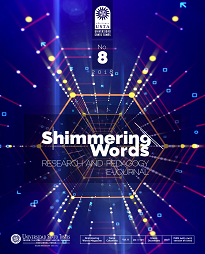Man, language and communication through time
Main Article Content
Abstract
The man´s development is directly linked to the development of language; his relationship implies a transaction of knowledge, ideas and concepts that modify the society in which he is a part. This paper gives a vision of the evolution of language through time, the importance of communication in the modern world and the acquisition of a second language (English) as a tool to face the advances and implications of globalization.
Likewise, there are concepts about the relevance of language in terms of economic, cultural, social, symbolic and linguistic capital and how these issues determine the progress of a community in the educational field.
Likewise, there are concepts about the relevance of language in terms of economic, cultural, social, symbolic and linguistic capital and how these issues determine the progress of a community in the educational field.
Article Details
How to Cite
Alba Guío, F. E., & Escarria Carrillo, B. E. (2019). Man, language and communication through time. Shimmering Words: Research and Pedagogy E-Journal, 8, 161-176. Retrieved from http://revistas.ustatunja.edu.co/index.php/shimmering/article/view/1804
Section
Artículos-8
References
Bank for International Settlements, (2008). Range of Practices and Issues in
Economic Capital Frameworks. Press & Communications. Retrieved from: https://www.bis.org/publ/bcbs152.pdf
Bourdieu, P. (1985). Sozialer Raum und Klassen, Ffm (Suhrlamp.)
Chardenet, P. (2012). El capital (inter)lingüístico como determinante de las
movilidades espaciales y virtuales. Retrieved from: file:///C:/Users/USUARIO/Downloads/articulo-obsmac_chardenet-11-12%20(1).pdf
Ciuffani, B. (2017). Non- verbal Communication and Leadership. The impact of hand gestures used by leaders on follower job satisfaction. University of Twente. Netherlands. Retrieved from: file:///C:/Users/Docentes/Documents/Thesis_%20Bianca_%20Ciuffani_s1108905.p
Damerow, P. (2006). The origins of Writing as a problem of Historical.
Epistemology. Cuneiform Digital Library Journal. Max Plank Institute for the History of Science, Berlin. https://cdli.ucla.edu/files/publications/cdlj2006_001.pdf file:///C:/Users/Docentes/Downloads/2523-Texto%20del%20art%C3%ADculo-|8746-2-10-20131213.pdf file:///C:/Users/USUARIO/Downloads/article%20CARMEN%20HELENA%20GU|ERRERO.pdf
Ginsburgh, V., Ortuño-Otín and Weber, S. (2006). Learning Foreign Languages. Theoretical and Empirical Implication of the Selten and Pool Model. JEL Classification Numbers: C72, O52, Z13. Retrieved from: file:///C:/Users/USUARIO/Downloads/learning.pdf
Guerrero, C. (2010). Is English the key to access the wonders of the modern world? A Critical Discourse Analysis. Revista Javeriana. Signo y Pensamiento 57. Documentos de Investigación. Vo XXIX.
Guerrero, C. (2010). Is English the key to access the wonders of the modern
world? A Critical Discourse Analysis. Signo y Pensamiento, documentos de investigación, XXIX. Pp. 294-313. Bogotá Colombia. Revista Universidad Javeriana. Retrieved from: https://repozytorium.amu.edu.pl/bitstream/10593/11301/1/Communication_History_and_Its_Research_Subject.pdf
Jackendoff, R. (2006). How did Language begin? Linguistic Society of America. Retrieved from: https://www.linguisticsociety.org/sites/default/files/LanguageBegin.pdf
Kulczycki, E. (2011). Communication History and its Research Subject. National Science Centre. University of Poznan, Poland.
McWhorter, J. (2004). The Story of Human Languages Part I. Manhattan Institute. The Teaching Company. Retrieved from: https://www.emse.fr/~bsimon/documents%20p%E9dagogiques/p%E9dagogie/The
Muchemwa, S. (2013) (PDF) Use of Nonverbal Communication in the Classroom as a Way of Enhancing Classroom Teaching: A Case Study of Solusi High School, Zimbabwe.Prodedia, Social and Behavioral Science. Research-gate. Retrieved from: https://www.researchgate.net/publication/270848476/download
Olson, D. (2009). The History of Writing. Retrieved from: https://www.sagepub.com/sites/default/files/upm/binaries/27267_5276_Beard_Ch01.pdf
Rehfeld, D. (2008). Dimensions of Symbolic Capital, Modes of Distinctiveness of European city Regions Under Change. University of Applied Science Gelsenkirchen / Ruhr University Bochum. Retrieved from: https://www.iat.eu/aktuell/veroeff/2008/rehfeld01.pdf
Rubingh, M. (2017). Japanese Communicative English and English as a Lingua Franca. Retrieved from: https://openaccess.leidenuniv.nl/bitstream/handle/1887/52262/Mick%20Rubingh%0s1060953%20Master%20Thesis%20v1.0.pdf?sequence=2
Trimmnel lE. (2005). Why You Need a Foreign Language & How to Learn One: Second Edition 2nd Edition.
Economic Capital Frameworks. Press & Communications. Retrieved from: https://www.bis.org/publ/bcbs152.pdf
Bourdieu, P. (1985). Sozialer Raum und Klassen, Ffm (Suhrlamp.)
Chardenet, P. (2012). El capital (inter)lingüístico como determinante de las
movilidades espaciales y virtuales. Retrieved from: file:///C:/Users/USUARIO/Downloads/articulo-obsmac_chardenet-11-12%20(1).pdf
Ciuffani, B. (2017). Non- verbal Communication and Leadership. The impact of hand gestures used by leaders on follower job satisfaction. University of Twente. Netherlands. Retrieved from: file:///C:/Users/Docentes/Documents/Thesis_%20Bianca_%20Ciuffani_s1108905.p
Damerow, P. (2006). The origins of Writing as a problem of Historical.
Epistemology. Cuneiform Digital Library Journal. Max Plank Institute for the History of Science, Berlin. https://cdli.ucla.edu/files/publications/cdlj2006_001.pdf file:///C:/Users/Docentes/Downloads/2523-Texto%20del%20art%C3%ADculo-|8746-2-10-20131213.pdf file:///C:/Users/USUARIO/Downloads/article%20CARMEN%20HELENA%20GU|ERRERO.pdf
Ginsburgh, V., Ortuño-Otín and Weber, S. (2006). Learning Foreign Languages. Theoretical and Empirical Implication of the Selten and Pool Model. JEL Classification Numbers: C72, O52, Z13. Retrieved from: file:///C:/Users/USUARIO/Downloads/learning.pdf
Guerrero, C. (2010). Is English the key to access the wonders of the modern world? A Critical Discourse Analysis. Revista Javeriana. Signo y Pensamiento 57. Documentos de Investigación. Vo XXIX.
Guerrero, C. (2010). Is English the key to access the wonders of the modern
world? A Critical Discourse Analysis. Signo y Pensamiento, documentos de investigación, XXIX. Pp. 294-313. Bogotá Colombia. Revista Universidad Javeriana. Retrieved from: https://repozytorium.amu.edu.pl/bitstream/10593/11301/1/Communication_History_and_Its_Research_Subject.pdf
Jackendoff, R. (2006). How did Language begin? Linguistic Society of America. Retrieved from: https://www.linguisticsociety.org/sites/default/files/LanguageBegin.pdf
Kulczycki, E. (2011). Communication History and its Research Subject. National Science Centre. University of Poznan, Poland.
McWhorter, J. (2004). The Story of Human Languages Part I. Manhattan Institute. The Teaching Company. Retrieved from: https://www.emse.fr/~bsimon/documents%20p%E9dagogiques/p%E9dagogie/The
Muchemwa, S. (2013) (PDF) Use of Nonverbal Communication in the Classroom as a Way of Enhancing Classroom Teaching: A Case Study of Solusi High School, Zimbabwe.Prodedia, Social and Behavioral Science. Research-gate. Retrieved from: https://www.researchgate.net/publication/270848476/download
Olson, D. (2009). The History of Writing. Retrieved from: https://www.sagepub.com/sites/default/files/upm/binaries/27267_5276_Beard_Ch01.pdf
Rehfeld, D. (2008). Dimensions of Symbolic Capital, Modes of Distinctiveness of European city Regions Under Change. University of Applied Science Gelsenkirchen / Ruhr University Bochum. Retrieved from: https://www.iat.eu/aktuell/veroeff/2008/rehfeld01.pdf
Rubingh, M. (2017). Japanese Communicative English and English as a Lingua Franca. Retrieved from: https://openaccess.leidenuniv.nl/bitstream/handle/1887/52262/Mick%20Rubingh%0s1060953%20Master%20Thesis%20v1.0.pdf?sequence=2
Trimmnel lE. (2005). Why You Need a Foreign Language & How to Learn One: Second Edition 2nd Edition.

